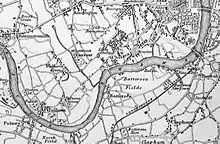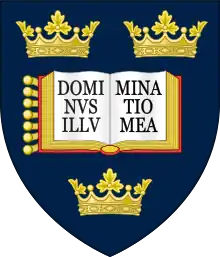The Boat Race 1840
The 4th Boat Race took place on the River Thames on 15 April 1840. It was the third of the University Boat Races to be held on the Thames, between Westminster Bridge and Putney Bridge. Oxford University Boat Club was formed to assist in the selection of the Oxford crew. Nevertheless, Cambridge won the race by three-quarters of a length to lead the overall record at 3–1.
| 4th Boat Race | |||
|---|---|---|---|
| Date | 15 April 1840 | ||
| Winner | Cambridge | ||
| Margin of victory | 3/4 length | ||
| Winning time | 29 minutes 3 seconds | ||
| Overall record (Cambridge–Oxford) | 3–1 | ||
| Umpire | C. Bewicke (Oxford) C. J. Selwyn (Cambridge) W. H. Harrison (referee) | ||
| |||
Background

The Boat Race is a side-by-side rowing competition between the University of Oxford (sometimes referred to as the "Dark Blues")[1] and the University of Cambridge (sometimes referred to as the "Light Blues").[1] The race was first held in 1829, and takes place on the River Thames in southwest London.[2][3]
Following heavy defeats in the 1836 and 1839 races, and in order to improve the selection of the crew, Oxford University Boat Club was formed on 23 April 1839,[4] to which anyone at the university could subscribe and which was governed by the various college boat club captains.[5] The initial letter of challenge was delivered to Cambridge from Oxford in February. After considerable discussion, mainly about the restriction of crew selection to undergraduates only, the date of the race, 15 April 1840,[6] was agreed sixteen days prior to the race itself.[7] The umpires for the race were Calverley Bewicke (for Oxford) and Charles Jasper Selwyn (for Cambridge), while W. H. Harrison, the Commodore of the Royal Thames Yacht Club, was the referee.[8] The race was to take place on a five-and-three-quarter-mile (9.2 km) stretch of the Thames between Westminster Bridge and Putney Bridge.[9][10]
Crews
The Oxford crew weighed an average of 11 st 10.5 lb (74.4 kg) per rower, 2.5 pounds (1.1 kg) more per man than their opponents.[11] Cambridge saw former Blues Alfred Shadwell and cox Thomas Selby Egan return, while Oxford's crew also contained two veterans of the race, in Samuel Maberly and R. G. Walls.[11]
| Seat | Cambridge |
Oxford | ||||
|---|---|---|---|---|---|---|
| Name | College | Weight | Name | College | Weight | |
| Bow | Alfred Hudson Shadwell | St John's | 10 st 7 lb | Jacob G. Mountain | Merton | 11 st 0 lb |
| 2 | William Massey | 1st Trinity | 11 st 0 lb | I. J. J. Pocock | Merton | 11 st 2 lb |
| 3 | Sam. Barnard Taylor | 1st Trinity | 11 st 7 lb | S. E. Maberley | Christ Church | 11 st 4 lb |
| 4 | John M. Ridley | Jesus | 12 st 8 lb | W. Rogers | Balliol | 12 st 10 lb |
| 5 | George Charles Uppleby | Magdalene | 11 st 12 lb | R. G. Walls | Brasenose | 12 st 7 lb |
| 6 | Francis Cranmer Penrose | Magdalene | 12 st 1 lb | E. Royds | Brasenose | 12 st 4 lb |
| 7 | Heighway C. Jones | Magdalene | 11 st 9 lb | Godfrey Meynell | Brasenose | 11 st 10 lb |
| Stroke | Charles M. Vialls (P) | 3rd Trinity | 11 st 6 lb | J. J. T. Somers Cox (P) | Brasenose | 11 st 3 lb |
| Cox | T. S. Egan | Gonville & Caius | 9 st 0 lb | W. B. Garnett | Brasenose | 9 st 7 lb |
| Source:[11][12] (P) – boat club president[13] | ||||||
Race

Oxford won the toss and elected to start from the Middlesex side of the river, handing the Surrey side to Cambridge.[11] The race commenced from below Westminster Bridge at 1.30 p.m., with Edward Searle acting as the starter.[12] With a number of steamers blocking the route, Oxford made a good start and took an early lead. The wake of the steamers caused rough water in which both crews struggled to maintain a consistent rhythm. The lead had extended by the time the crews passed below Vauxhall Bridge and was nearly three lengths by the Spread Eagle pub. At this point Cambridge began to reduce the deficit, but following a warning from Robert Coombes who was steering the umpire's boat Dolphin, Oxford's cox Garnett steered across the path of Cambridge. The Light Blues maintained their course and Oxford were forced back again. By the Red House, Cambridge had restored parity and started to pull away. Despite suffering further rough water from the wake of another steamer at Battersea Bridge, Cambridge maintained their lead and passed through the centre arch of Putney Bridge three-quarters of a length ahead of Oxford.[14] The winning time was 29 minutes 3 seconds, and the victory took the overall lead to 3–1 in favour of Cambridge.[11][15]
References
Notes
- "Dark Blues aim to punch above their weight". The Observer. 6 April 2003. Archived from the original on 11 September 2014. Retrieved 1 September 2014.
- Smith, Oliver (25 March 2014). "University Boat Race 2014: spectators' guide". The Daily Telegraph. Archived from the original on 1 July 2014. Retrieved 1 September 2014.
- "The Course". The Boat Race Company Limited. Archived from the original on 28 October 2014. Retrieved 1 September 2014.
- Burnell, p. 4
- MacMichael, p. 69
- "Boat Race – Early races". The Boat Race Company Limited. Archived from the original on 7 November 2014. Retrieved 22 April 2014.
- MacMichael, pp. 69–70
- Burnell p. 49
- "The Boat Race". Oxford University Boat Club. Archived from the original on 21 April 2014. Retrieved 22 April 2014.
- "Putney". British History Online. Archived from the original on 30 October 2014. Retrieved 29 October 2014.
- Dodd, p. 287
- MacMichael, p. 71
- Burnell, pp. 50–51
- MacMichael, pp. 72–74
- "Boat Race – Results". The Boat Race Company Limited. Archived from the original on 12 July 2016. Retrieved 26 October 2014.
Bibliography
- Burnell, Richard (1979). One Hundred and Fifty Years of the Oxford and Cambridge Boat Race. Precision Press. ISBN 978-0-9500638-7-4.
- Dodd, Christopher (1983). The Oxford & Cambridge Boat Race. Stanley Paul. ISBN 978-0-09-151340-5.
- Drinkwater, G. C.; Sanders, T. R. B. (1929). The University Boat Race – Official Centenary History. Cassell & Company, Ltd.
- MacMichael, William Fisher (1870). The Oxford and Cambridge Boat Races: From A.D. 1829 to 1869. Deighton.
boat race oxford cambridge.

